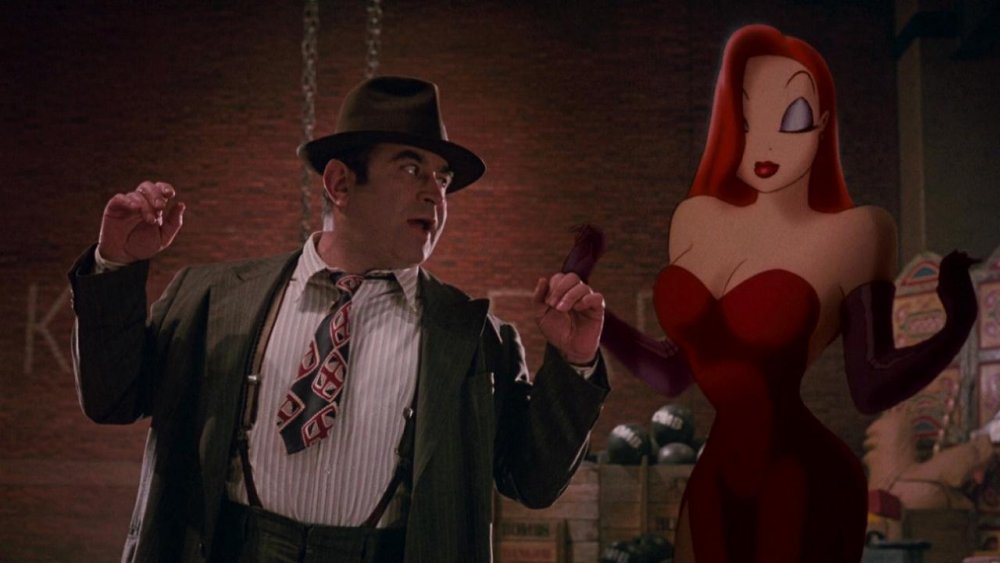Otto Penzler ranks, analyzes, & celebrates the 106 greatest crime films of all-time. Catch up on the series and find new installments daily here.
__________________________________
Who Framed Roger Rabbit? (1988)
__________________________________
TYPE OF FILM: Detective/Comedy
STUDIO: Touchstone-Amblin Silver Screen
EXECUTIVE PRODUCERS: Steven Spielberg and Kathleen Kennedy
PRODCUERS: Robert Watts and Frank Marshall
DIRECTOR: Robert Zemeckis
SCREENWRITERS: Jeffrey Price and Peter S. Seaman
SOURCE: Who Censored Robert Rabbit? Novel by Gary K. Wolf
RUNNING TIME: 110 minutes
PRINCIPAL PLAYERS:
Bob Hoskins……………………………………….…………………………………Eddie Valiant
Christopher Lloyd……………………………………………………………..………Judge Doom
Joanna Cassidy……………………………………………………………………………..Dolores
Stubby Kaye…………………………………………………………………………Marvin Acme
Alan Tilvern……………………………………………………..……………………R.K. Maroon
Charles Fleischer………..……Voices of Roger Rabbit, Benny the cab, and others
Lou Hirsch……………………………………………………………..…..Voice of Baby Herman
Mel Blanc…………………………Voices of Daffy Duck, Tweety Bird, and others
__________________________________
DID YOU KNOW?
__________________________________
Actor Bob Hoskins managed perhaps the most difficult achievement of his applaudable career by acting and interacting with empty space. As most of those playing opposite of him are cartoon characters who were drawn into the frames after the live acting was completed, Hoskins had to pretend he was speaking to someone, fighting with someone, engaged in a tug-of-war, etc., while in fact he was going it solo. To help prepare for the part he watched his young daughter so that he could learn to act with imaginary characters. His son, meanwhile, was angry with him for failing to bring his cartoon costars home with him so that they could be introduced to, and play with, the young boy. Hoskins later had problems with frequent and believable hallucinations.
__________________________________
THE STORY
__________________________________

In 1947 Los Angeles, Roger Rabbit is a “Toon,” a derogatory term for the characters who can perform many extraordinary things and suffer from great violence without suffering serious injury but are despised by humans for their free-spirited, fun-loving ways. They are permitted to work in Hollywood with humans but then must return to Toontown, segregated from the rest of society.
When Roger seems to lack focus in his films, the owner of Maroon Cartoons guesses that he must be having marital problems, so he hires Eddie Valiant, a two-bit private detective, to check up on Roger’s wife, Jessica Rabbit. Valiant hates Toons, whom he believes murdered his brother, a cop, by dropping a safe on his head.
Valiant spots Jessica backstage at the nightclub where she sings, playing patty-cake (literally) with Marvin Acme, a prop supplier, and provides photographs to Roger. The next day, Acme is found murdered, a safe having been dropped on his head, and Roger is suspected.
Acme’s death in a severe blow to the Toons because he owned the land on which Toontown was built and he had always acted kindly towards them. Roger swears he is innocent and hires the reluctant Valiant to find evidence that will clear his name.
Judge Doom, a Toon-hating human, is eager to catch Roger and kill him with his invention, “The Dip,” which is the only certain way to kill a Toon—it erases them. Doom wants Roger out of the way because he has a plan to use the land for an off-ramp for a massive highway network that will replace the clean, efficient, and inexpensive trolley system currently in use.
Valiant traces the murder to Judge Doom, and a battle between the detective and the villain ensues, with the lives of Roger and Jessica, and all in Toontown, at stake. A giant steamroller, brought to Toontown to spray “The Dip” all over it and wipe out everyone and everything, runs over Judge Doom during the battle. When he immediately pops up, alive and unhurt, he reveals that he is a Toon himself, finally melting and being erased by his own mixture of death, saving the Rabbits, who love each other, and Toontown and its residents.
***
Who Framed Roger Rabbit?, in addition to being one of the most entertaining films of modern times, is also one of the most innovative. It combines human and animation figures so realistically that audiences suspend disbelief after a few scenes and are as concerned with Toon characters as they would be with human actors.
This was not the first time that animation was mixed with real-life actors, Disney having done it in Song of the South (1946) and again in Marry Poppins (1964), and Warner Brothers doing it briefly in a 1940 cartoon by Fritz Freleng, You Ought to Be in Pictures, in which Porky Pig and Daffy Duck demand better treatment from the real-life animation-department head Leon Schlesinger.
Although it was not the first, Who Framed Roger Rabbit? displays by far the most accomplished and ambitious use of this difficult technique, making the interaction between cartoons and real-life characters utterly convincing. The near-miraculous achievement of George Lucas’s Industrial Light and Magic Company, the director of animation, Richard Williams, and literally hundreds of animators cannot be praised too highly.
Perhaps equally miraculous is that all the major film studios cooperated in the production, an unheard-of agreement in the highly competitive and protective world of Hollywood, where copyrights and trademarks are the fountain from which countless dollars flow. Disney permitted the use of Mickey Mouse and Donald Duck, Warner Brothers allowed Bugs Bunny and Daffy Duck to appear, Paramount gave permission for Betty Boop, Universal agreed to let Woody Woodpecker make an appearance, and virtually every other well-known cartoon character has at least a cameo role.
Kathleen Turner supplied the speaking voice of Jessica Rabbit but was uncredited; Amy Irving supplied her singing voice.
__________________________________
BEST LINE
__________________________________
Jessica Rabbit, who looks like an incredibly sexy human, is uncomfortable with her voluptuous figure, and tells Eddie Valiant, “You don’t know what it’s like being a woman looking the way I do.” Valiant replies, “You don’t know what it’s like being a man looking at a woman looking the way you do.” Later, Jessica says, “I’m not bad. I’m just drawn that way.”


















